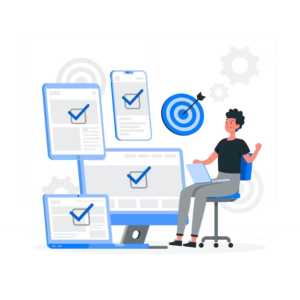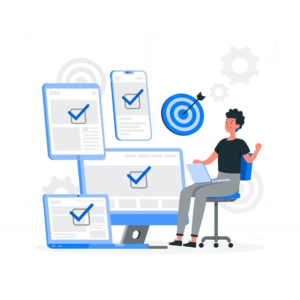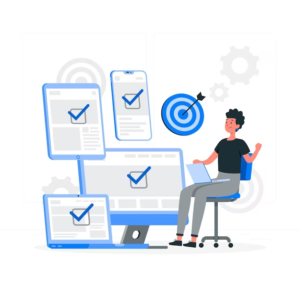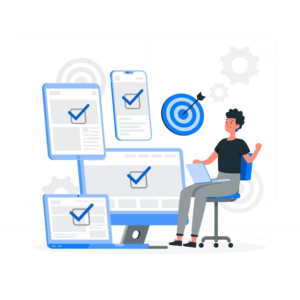Data analytics examines, cleans, transforms, and interprets data to discover valuable insights. In today’s data-driven world, businesses and individuals rely on data analytics tools to make informed decisions, identify trends, and gain a competitive edge. This article delves into data analytics tools, exploring their descriptions, features, pros, and cons while guiding you to choose the right tool for your needs.
What Is Data Analytics?
Before diving into data analytics tools, it’s crucial to grasp the essence of data analytics itself. Data analytics encompasses a range of techniques and processes aimed at examining and interpreting data to uncover meaningful patterns, trends, and insights. Whether business intelligence, data mining, or predictive modeling, data analytics is pivotal in making data actionable.
What Are Data Analytics Tools?
Data Analytics Tools are software applications or platforms that facilitate data analysis and visualization. These tools vary widely in complexity, catering to everyone from beginners to data scientists. They empower users to explore data, generate reports, and quickly draw insights.
Top 15 Data Analytics Tools
Here is a curated list of 15 data analytics tools, each with its strengths and capabilities:
- Tableau
- Microsoft Power BI
- Google Analytics
- Python
- R
- IBM Watson Analytics
- SAS Analytics
- Apache Hadoop
- Apache Spark
- KNIME
- RapidMiner
- Alteryx
- QlikView
- Orange
- SAP Analytics Cloud
Now, let’s delve deeper into each tool, exploring its unique features, advantages, and potential drawbacks.
Data Analytics Tools #1 Tableau
Tableau is a leading data visualization and analytics tool known for its user-friendly interface and robust visualization capabilities. It enables users to create interactive dashboards, reports, and charts.
Features:
- Intuitive drag-and-drop interface
- Wide range of data connectors
- Real-time data analysis
Pros:
- Exceptional visualization options
- Strong community support
- Suitable for both beginners and experts
Cons:
- Relatively high cost for enterprise editions
- Steeper learning curve for advanced features
Data Analytics Tools #2 Microsoft Power BI
Microsoft Power BI is a powerful business intelligence tool that seamlessly integrates with Microsoft’s suite of products. It offers data modeling, interactive reports, and data-driven insights.
Features:
- Seamless integration with Microsoft products
- Natural language queries
- Power Query for data transformation
Pros:
- Cost-effective, especially for Microsoft users
- Strong sharing and collaboration features
- Extensive library of pre-built visuals
Cons:
- Limited customization for visuals
- Learning curve for complex data models
Data Analytics Tools #3 Google Analytics
Google Analytics is a web analytics service that tracks and reports website traffic and user behavior. It provides valuable insights for website optimization and digital marketing campaigns.
Features:
- Real-time traffic monitoring
- Conversion tracking
- Integration with Google Ads
Pros:
- Free version available
- Comprehensive web analytics for websites of all sizes
- Integration with other Google services
Cons:
- Limited to web analytics
- Advanced features may require a learning curve
Data Analytics Tools #4 Python
Python is a versatile programming language widely used for data analysis and machine learning. It offers numerous libraries and frameworks, such as Pandas and NumPy, for data manipulation and analysis.
Features:
- Extensive data analysis libraries
- Open-source and free
- Strong community support
Pros:
- Flexible and powerful for data analysis
- Ideal for custom data workflows
- Supports integration with other data tools
Cons:
- Requires programming skills
- It may not be as user-friendly as GUI-based tools.
Data Analytics Tools #5 R
R is a programming language and software environment specifically designed for statistical computing and graphics. It is popular among statisticians and data analysts for data visualization and analysis.
Features:
- The rich ecosystem of statistical packages
- Comprehensive data visualization capabilities
- Ideal for statistical modeling
Pros:
- Powerful for statistical analysis
- Extensive libraries for data manipulation
- Active community and package development
Cons:
- The steeper learning curve for beginners
- Less suitable for general-purpose programming
Data Analytics Tools #6 IBM Watson Analytics
IBM Watson Analytics is a cloud-based data analytics platform that integrates machine learning and AI capabilities. It is designed to assist users in data exploration, predictive analysis, and visual storytelling.
Features:
- Natural language query for data exploration
- Predictive analytics and machine learning models
- Automated data preparation
Pros:
- User-friendly with a focus on business users
- Advanced analytics without coding
- Integration with various data sources
Cons:
- Limited customization options for advanced users
- Costs can escalate with increased usage
Data Analytics Tools #7 SAS Analytics
SAS Analytics is a comprehensive suite of analytics software solutions for advanced analytics, business intelligence, and data management. It is widely used in industries requiring advanced statistical analysis.
Features:
- Advanced statistical analysis capabilities
- Data integration and cleansing
- Data mining and predictive modeling
Pros:
- Powerful for advanced analytics
- Enterprise-level data management
- Extensive support and resources
Cons:
- Higher cost, especially for small businesses
- Learning curve for non-technical users
Data Analytics Tools #8 Apache Hadoop
Apache Hadoop is an open-source framework for distributed storage and processing of large datasets. It is renowned for its scalability and ability to handle big data workloads.
Features:
- Distributed storage and processing with HDFS and MapReduce
- Scalable architecture
- Integration with various data processing frameworks
Pros:
- Ideal for processing and analyzing massive datasets
- Cost-effective storage and processing
- Thriving open-source community
Cons:
- Requires technical expertise to set up and manage
- Complexity may not be suitable for smaller projects
Data Analytics Tools #9 Apache Spark
Apache Spark is an open-source, distributed computing system designed for big data processing. It offers advanced analytics, machine learning, and graph processing capabilities.
Features:
- In-memory data processing for speed
- A broad range of libraries for data analytics
- Scalable and versatile
Pros:
- High-speed data processing
- Comprehensive libraries for data science tasks
- Integration with various data sources
Cons:
- The learning curve for beginners
- Resource-intensive for large-scale deployments
Data Analytics Tools #10 KNIME
KNIME (Konstanz Information Miner) is an open-source data analytics platform known for its drag-and-drop interface for building data workflows. It offers various data integration, transformation, and analysis capabilities.
Features:
- Visual workflow builder
- Integration with numerous data sources and formats
- Extensive library of data processing nodes
Pros:
- User-friendly, no coding required
- Active and supportive community
- Ideal for data preparation and transformation
Cons:
- Limited advanced analytics compared to some tools
- Steeper learning curve for advanced features
Data Analytics Tools #11 RapidMiner
RapidMiner is a data science platform that provides an integrated environment for data preparation, machine learning, and predictive analytics. It is widely used for building and deploying predictive models.
Features:
- User-friendly drag-and-drop interface
- Extensive library of machine learning algorithms
- Automated machine learning (AutoML) capabilities
Pros:
- Easy to use for data scientists and analysts
- Supports end-to-end data science workflows
- Active community and marketplace for extensions
Cons:
- Limited for non-technical users
- Pricing can be high for enterprise editions
Data Analytics Tools #12 Alteryx
Alteryx is a data analytics platform designed for data blending, advanced analytics, and predictive modeling. It empowers users to prepare, blend, and analyze data without coding.
Features:
- Visual data preparation and blending
- Predictive analytics and machine learning
- Geospatial analytics capabilities
Pros:
- User-friendly for data preparation
- Extensive data connectivity options
- Ideal for geospatial and location analytics
Cons:
- It can be expensive for small businesses.
- The learning curve for advanced analytics
Data Analytics Tools #13 QlikView
QlikView is a business intelligence and data analytics tool known for its associative data model. It enables users to explore data from different angles, uncovering hidden insights and relationships.
Features:
- Associative data model for in-depth exploration
- Interactive and customizable dashboards
- Strong data security and governance features
Pros:
- Excellent for exploring complex datasets
- Rapid application development capabilities
- Robust data governance and security
Cons:
- Higher licensing costs
- Requires skilled developers for advanced features
Data Analytics Tools #14 Orange
Description: Orange is an open-source data visualization and analysis tool with a focus on machine learning and data mining. It offers a visual programming interface for creating data workflows.
Features:
- Visual programming for data analysis
- Wide range of machine learning algorithms
- Data visualization and exploration
Pros:
- User-friendly and suitable for beginners
- Comprehensive machine learning capabilities
- Extensible with add-ons and widgets
Cons:
- Less suitable for advanced data transformation
- Limited support for big data
Data Analytics Tools #15 SAP Analytics Cloud
SAP Analytics Cloud is a cloud-based analytics platform that combines business intelligence, augmented analytics, and planning in one solution. It provides capabilities for data visualization, planning, and predictive analytics.
Features:
- Integration with SAP and other data sources
- Collaboration and planning features
- Smart analytics with machine learning
Pros:
- Seamless integration with SAP systems
- User-friendly for business users
- Strong support for planning and forecasting
Cons:
- Pricing can be high for small businesses
- The learning curve for complex analytics scenarios
How to Choose the Best Data Analytics Tool?
Selecting the right data analytics tool depends on your specific requirements. Consider the following factors:
- Data Sources: Evaluate whether the tool can connect to your data sources, ensuring compatibility with your data infrastructure.
- User Skill Level: Choose a tool that matches the skill level of your users, whether they are beginners or experienced data analysts.
- Budget: Factor in the cost of the tool, including any additional licensing fees and subscription costs.
- Scalability: Ensure the tool can accommodate your organization’s growth and evolving data needs.
- Customization: Consider how much control you need over the look and feel of your visualizations and analysis.
- Support and Community: Check for available support resources and an active user community for troubleshooting and learning.
The decision ultimately depends on your unique business needs and goals. Considering these factors will help you choose your organization’s best data analytics tool.
Conclusion
In conclusion, data analytics tools are essential for individuals and organizations seeking valuable insights from data. Whether you require user-friendly visualization, advanced statistical analysis, or big data processing, there’s a tool tailored to your needs.
Choosing the right data analytics tool involves evaluating data sources, user skill level, budget, scalability, customization, and available support. By carefully considering these aspects, you can make an informed decision that aligns with your organization’s goals and objectives.
Ultimately, the best data analytics tool for your organization will empower you to unlock the full potential of your data, drive smarter decisions, and gain a competitive edge in today’s data-driven world.



